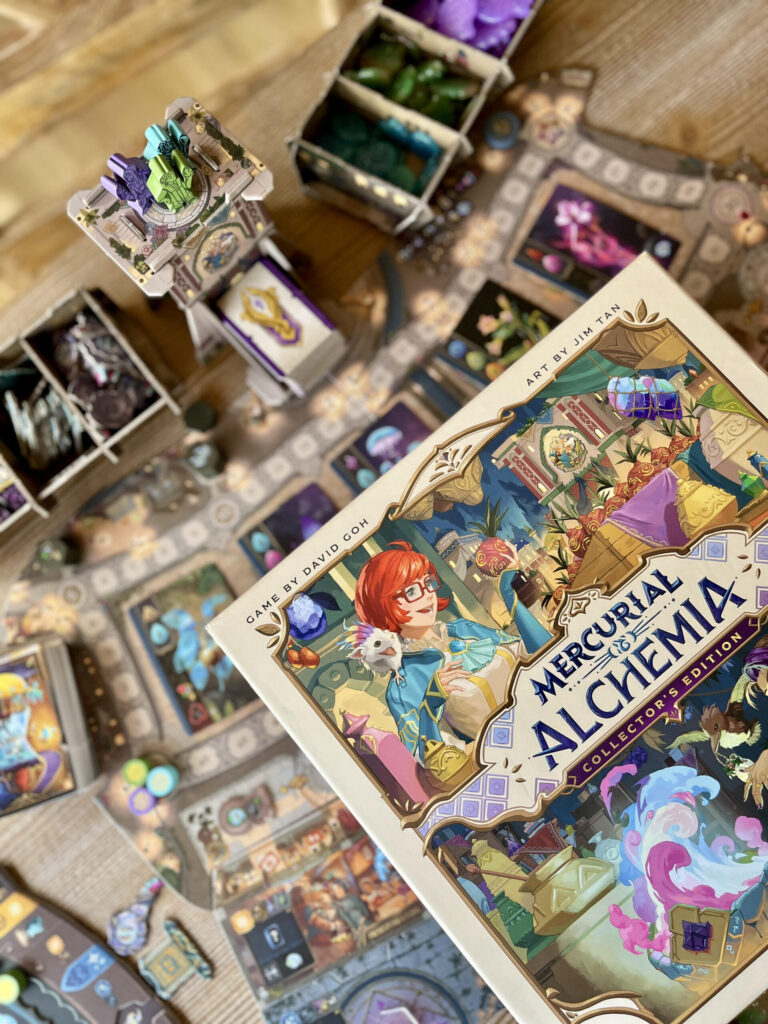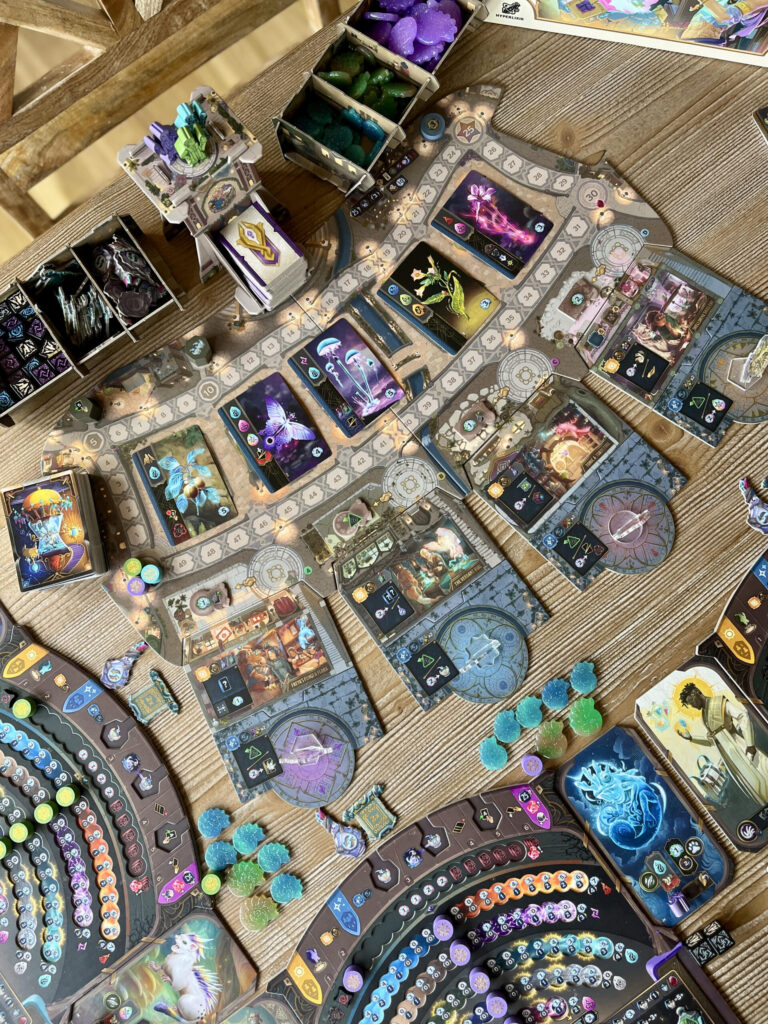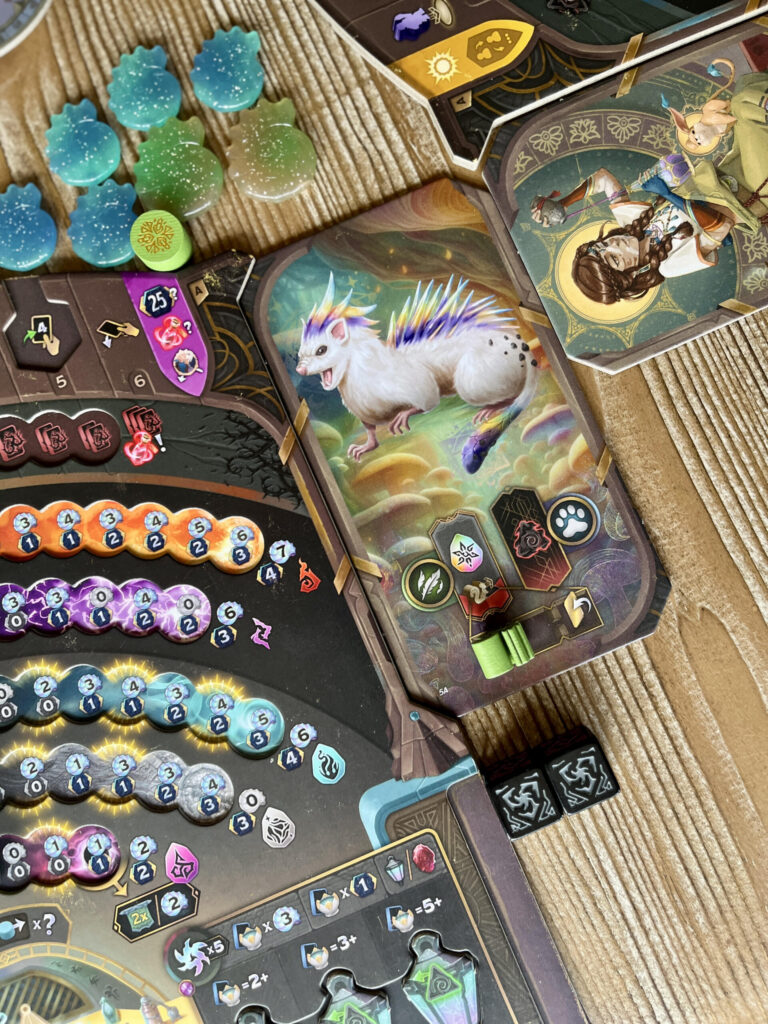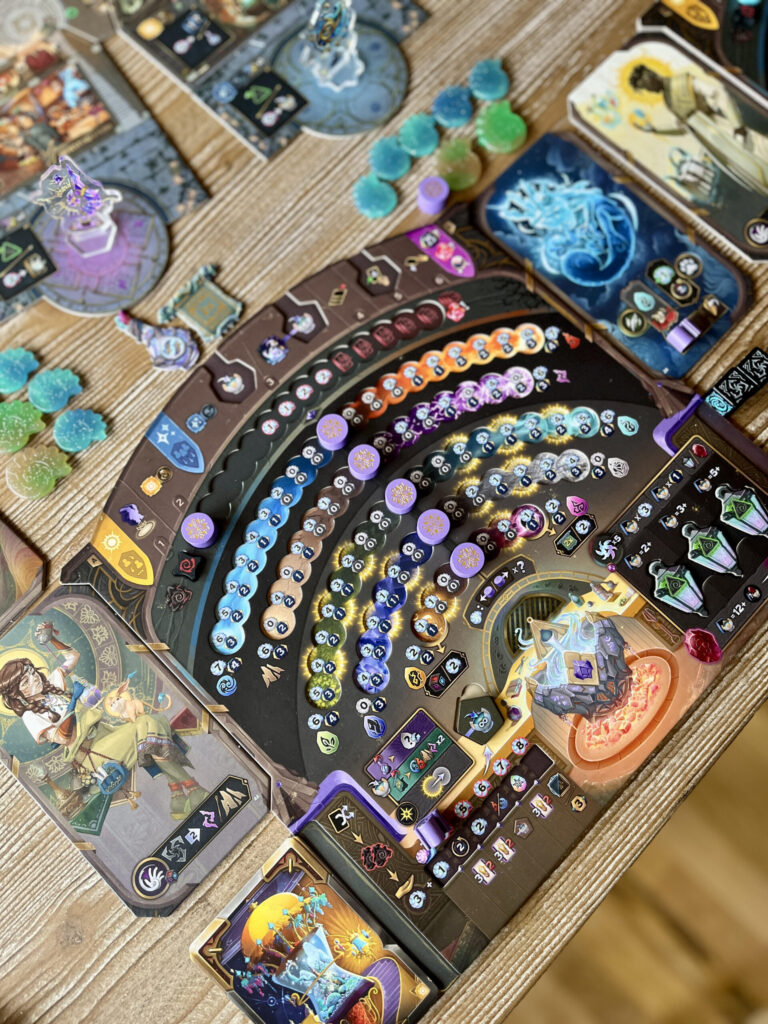Man, if I were some big shot Hollywood-type chick, my people’s ass would be on the phone this instant with Hyperlixer’s people’s ass, securing the movie rights to this game. The world of Mercurial: Alchemia would absolutely kill on the big screen. Face tattoos! Fantasy bazaar! Colorful pets! Magic potions! Weird, edgy looking characters! The world’s already built so an adaptation to screenplay would be cake.
The funny thing is, I’m not actually drawn to this art style generally. It’s giving young adult romantasy vibes and I am a very serious, very mature woman of 34 who only watches prestige content like Virgin River and Seinfeld. But credit where it’s due: the world is vibrant, immersive, and fun. And until that inevitable three-hour A24 art epic arrives, we’ve got the actual board game.

Here’s how it plays: you’re an alchemist-in-training, walking around the bazaar trying to buy ingredients and brew potions. The game runs over a series of “days” until someone hits 25 points, then you wrap up with final scoring. Each day has two parts: day and night. In the day phase, you pick a shop and take its action…maybe buying cards, reagents and catalysts to balance your potion, or advancing your income track. Other players can piggyback on your choice, “joining” your action, by paying extra to do the same.
When night falls, you’re locked into that shop’s paired night action, which always includes infusing an ingredient into your potion, but may also purge a card from your hand or do other useful deckbuilding things. Infused ingredients push markers along tug-of-war tracks (like fire vs. water), rewarding you more the further you commit down a path. If you start infusing fire ingredients, you’re gonna want to avoid infusing water ingredients as best you can. But many of the stronger cards you purchase from the market provide multiple elements and materials and you must infuse all of them, whether you want to or not.
Now, instead of shopping, you can choose to forego your day action and brew a potion at night. You’ll infuse ingredients via the cards in your hand, spend dice to infuse even more, and use catalysts and reagents to balance things out. Then appraise it for points, money, and usually a bit of nasty Blight, which can potentially lead toward clogging your deck with negative cards.

Progress feels rewarding: the score track gives upgrades like more ingredients per brew or a bigger hand size, while the income track boosts end-game perks, payouts, and dice. Over time, your concoctions clearly grow in power and this feels good. The potion brewing really carries the deckbuilding to the next level by giving it an interesting purpose and giving you reason to consider carefully which cards you will purchase.
It helps that the whole thing looks and feels premium. I was sent a temporary copy of the Collector’s Edition, and the production value is stellar. The Glimmershells (the in-game currency) are chunky, glittery plastic which maybe doesn’t sound so great when described but feel surprisingly satisfying in hand. Triple-layered player boards keep all your moving pieces in place. The storage solution makes setup pretty painless. Add in the height and depth, color, and detailed artwork, and the table presence is undeniable. From what I understand, the Collector’s Edition is exclusive to Kickstarter, with a retail version coming later. I can’t speak to how that one will look, but the prototype Collector’s Edition is impressive.

However, not everything feels revolutionary. It feels like a solid deckbuilder and it has some fun riffs on well-known mechanics (the tug-of-war tracks and constantly evaluating which direction to commit to), but it’s definitely familiar. It’s also a touch visually busy, and we missed a few open card slots that should have been refilled. Sitting on the upside-down side of the board isn’t ideal either, because it’s pretty physically oriented for facing right-side-up, though once you know the actions, reading is minimal.
What surprised me the most is how quiet the game is. Like pretty much multiplayer solitaire, aside from a little table politicking. Someone might buy a card you were eyeing, but otherwise your choices don’t interfere with others. Turns move quickly, but you still need to consider your entire turn before you take it, so there will be some thinking time. Even so, downtime never dragged in our plays…90 minutes solo, up to 2.5 hours at higher counts, but mostly landing at about 2 hours. Everyone stayed engaged, thanks in part to simultaneous night phases.
Replayability is a huge strength of the game. Shops and night actions can be flipped or rearranged, bonus tiles can be swapped for new effects, and while most character tiles feel similar (only two noticeably shift your playstyle), the arcana tiles, which are your pets, offer fun asymmetric bonuses. You can also flip the player boards over for asymmetric characters. I only played one and it basically had me hone in on a specific aspect of play. If I had the game for longer, I think I would actually be happy to play symmetrically for quite a while, because there’s so much there. Still, nice to have the option.
There’s also an alternate mode, Equilibrium, that completely changes the experience. In the standard game you’re pushing your potion tracks as far toward one element as possible. In Equilibrium, the goal is the opposite…you’re trying to keep everything balanced in the middle. That means intentionally infusing opposing ingredients and approaching deckbuilding with a totally different mindset. I found it forced me to pay much closer attention to card counts and track exactly what was in my deck, since one wrong infusion could throw the whole balance off. It’s different and exciting enough that it feels like a whole new game.

The solo and two-player modes are also well thought out. Solo pits you against two AI alchemists, run by quick action cards that simulate market pressure without worrying about resource tracking. Each bot takes like 30 seconds to run and it’s decently tough. I lost three times on easy but got closer each play, which felt fair, rather than unbalanced. Two-player mode adds an even simpler AI that mostly fills space and keeps the market moving. Normally I dislike bots in 2p games, but this one was light enough that I hardly had to think about it.
All told, there’s a lot to admire. It’s got great player aids, it feels well-balanced at each player count, and it keeps the focus on your own engine building rather than tearing someone else’s down. It’s the opposite of a mean game. Personally, I enjoy a little sabotage, but I can enjoy a friendly game with the best of them.
So while I don’t believe Mercurial: Alchemia is some genre-breaking revolution, it nails the spectacle and immersion, with fun gameplay to boot. If I were some big Hollywood producer, I’d green light it tomorrow. But luckily I don’t need that studio deal…just my game table. And look, if a Very Mature Adult ™ like me can get sucked into picturing this as a Hollywood shoe-in, then you know Hyperlixer’s done something right.
Thank you to Hyperlixer for the temporary prototype for this preview.